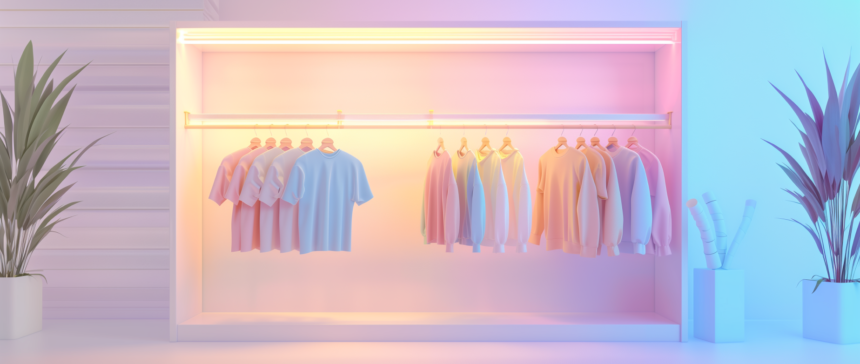As a small business owner, finding new and innovative ways to get your products into your customers’ hands can be an exciting yet challenging task. A pop-up shop is one effective strategy, allowing you to interact with customers in person while they engage with your products and brand—boosting sales in the process.
Whether you’re a seasoned seller or budding entrepreneur, this comprehensive guide can help you succeed with your next pop-up shop.
What is a pop-up shop?
A pop-up shop is a type of retail store that opens for a limited time in a location, like an empty retail space, an existing physical store, or a food or arts market. Pop-ups can take many forms, including booths, kiosks, or compact freestanding stores.
A business may start a pop-up in response to trends or seasonal demand, to test consumer demand for new products or services, or even to trial a temporary retail space.
The pop-up concept, also known as flash retailing, is an ideal opportunity for emerging, digitally native brands to try new and unique shopping experiences that online platforms can’t replicate. Importantly, with a pop-up, you don’t have to take on the financial risk and commitment of a permanent storefront to participate in brick-and-mortar retail.
Pop-Up Shop Quickstart Guide
Thinking about hosting a pop-up shop? This free guide includes three checklists that help frame what you’re looking to accomplish through your pop-up shop, different types of pop-up shops, and design ideas to help get you started.
What are the benefits of a pop-up shop?
If you’re considering expanding your ecommerce business into brick-and-mortar stores, launching a new product line, or pursuing a new target market, a pop-up shop may be your first step.
Creates an in-person connection with customers
In-person shopping remains attractive to most consumers, according to a 2024 IBM Institute for Business Value study. The global study of 20,000 consumers reported that 73% turned to physical stores when buying goods. Like traditional stores, pop-ups allow you to connect with your customers for an immersive personalized shopping experience. Since you’re engaging with shoppers on a more intimate level, it’s easier to build customer loyalty.
Builds buzz and awareness
A temporary pop-up shop with a definitive end date taps into a shopper’s fear of missing out (FOMO), leveraging a form of aspiration-based marketing known as FOMO marketing. FOMO marketing is behind 60% of sales, an indicator that for many shoppers it’s reason enough to buy.
Trials potential permanent physical locations
Pop-up shops require less upfront investment that a traditional brick-and-mortar store, which makes them an ideal testing ground. A successful pop-up can be an indicator that your business is ready for expansion into physical retail.
Unloads older inventory
Pop-up shops can be an effective means to sell old inventory. Incorporate visual merchandising elements into fresh displays to attract new shoppers. Offer special deals—such as buy one, get one free (BOGO) or product bundling—or other strategies to encourage impulse buys.
Types of pop-up shops
There are numerous types of pop-up shops to consider, depending on your business needs and goals. Here are some examples:
Marketing event pop-ups
Marketing event pop-ups are the type of pop-up brands use to generate buzz around a new product launch, rebranding campaign, or business launch. Your pop-up shop can serve as part of your overall marketing strategy for your retail business.
Seasonal pop-ups
Seasonal pop-up shops leverage seasonal characteristics to drive traffic and increase sales. The most common type of seasonal pop-up is the holiday pop-up shop. For some businesses, these shops tap into peak shopping season, which accounts for more than a quarter of their annual sales.
Chicago’s Christkindlmarket is an example of a seasonal market, where businesses create pop-up shops. Open from mid-November to near the end of each year, the Christkindlmarket offers consumers an interactive holiday event featuring locally made goods from dozens of vendors to purchase as gifts.

💡 PRO TIP: Thinking of opening a temporary retail location like a pop-up shop? Instead of buying your POS hardware, sign up for Shopify’s Hardware Rental Program to start selling fast.
Experimental pop-ups
As the name implies, an experimental pop-up is one where a business experiments with new products, markets, merchandising, or retail experiences before launching on a bigger scale.
Experimental pop-ups enable businesses to be innovative, test ideas, and bring creative products or concepts to an audience they might not otherwise reach. Take the MOMENT Marketplace pop-up that debuted in October 2023 as part of Google headquarters’ visitor experience. It’s an experimental pop-up offering a rotation of themes for its showcase of goods by local artisans. This type of pop-up can also enable business owners to gather valuable data around customer reactions and feedback.
Virtual pop-ups
Virtual pop-up shops offer an interactive virtual shopping experience where customers have the opportunity to browse your products in a digital storefront. These types of pop-ups simulate in-person shopping by allowing customers to virtually walk through your store and engage with your brand.
Unlike a traditional ecommerce website, virtual pop-ups are an interactive 360-degree shopping experience.

Shop-in-shops
A shop-in-shop is a shop set up within an established store. Retailers typically rent a portion of a store or boutique as a place to sell their products. Launching a pop-up in a store leverages the larger store’s existing foot traffic—helping you save money on rent and décor in the process.
💡 PRO TIP: Tap to Pay on iPhone for Shopify POS is the fastest way to start selling your products at events, farmers markets, or wherever your customers are. Download the Shopify POS app on your iPhone to accept contactless payments without having to buy hardware or a card reader.
How to set up a pop-up shop in 7 easy steps
- Choose a type of event space
- Pick a pop-up shop location
- Decide the shop type, interior, and exterior
- Collect any necessary legal paperwork
- Book your pop-up shop venue
- Market your pop-up
- Measure success
There are clear steps to be taken when deciding it’s time to set up your pop-up shop. Here’s what you need to know:
1. Choose a type of event space
It’s important to find the right spot for your pop-up shop. Consider working with a retail agent, networking with other small businesses within your community, or tapping into apps like IzyRent to discover available spaces. When evaluating a retail space, request a comprehensive estimate of your monthly payment, and what it includes.
There are a number of common spaces used for pop-up shops:
- Vacant storefronts
- Shopping centers or malls
- Shop-in-shops
- Galleries or event spaces
- Pop-up buses or other mobile options
2. Pick a pop-up shop location
To pick the best location for your pop-up shop, it’s important to conduct market research. This includes choosing a location based on factors such as accessibility, foot traffic trends, target demographic, and leasing costs, as well as completing a competitive analysis. The questions you should consider asking at this stage include:
- What are the shop’s goals?
- How much rent or leasing cost is affordable?
- Is the neighborhood or street considered a high-traffic area?
- Are passersby target customers?
If you’re looking to launch a new swimwear collection, somewhere near a beach might be best. If you’re trying to decide whether to make a permanent move into physical retail, use any currently available sales analysis data to figure out where most of your existing customers are.
💡TIP: To see where your customers are located and if they’re congregated in certain cities or neighborhoods, view the “Customers by location” report in Shopify admin.
3. Decide the shop type, interior, and exterior
Deciding the appropriate interior or exterior type includes knowing and understanding your audience, its needs and wants, and design psychology. If using an existing retail space, is the retail store layout and design suitable for your merchandise?
The way your shop looks on the inside and outside also depends on the types of products or services sold. For example, if you are a seller of kites, you might set up an open-air concept pop-up shop to mirror the airy vibe of your product—and fun, youthful mentality of your shoppers. You can hire a design consultant to help with these tasks.
Here’s a checklist of factors to help in your decision making:
- Square footage. Is the space big enough to allow shoppers to browse easily?
- Internet access. Is the space Wi-Fi ready? Ishigh-speed internet access available so your point-of-sale software runs smoothly, sales representatives can utilize mobile POS options, and you can leverage beacon technology?
- Stock space. Is there on-site storage or a stockroom to easily manage inventory? How much storage is available to hide visible inventory clutter?
- Anti-theft features. Does the space offer adequate loss prevention measures such as surveillance cameras or alarm systems to help monitor and prevent theft?
- Frontage. Does the storefront have a sidewalk for walk-ins and foot traffic? Is the frontage big enough so you can easily manage curbside pickup orders?
- Signage. Does the shop location come with signage and, if so, are you allowed to customize it?
- Parking and public transportation access. Is there free or metered on-site parking? Or is there access to public transit?
4. Collect any necessary legal paperwork
Depending on the region or state where you start your business, your industry, the length of the pop-up shop, your business size, and your number of employees, you may be required to get certain licenses or permits to operate your pop-up.
For example, many cities require a permit to sell food and alcohol. If you plan to serve champagne at your opening, secure the appropriate permit. Contact your local government agency or chamber of commerce for information on licensing and business permit requirements to ensure you are in compliance.
Additionally, business insurance (or commercial insurance) may be needed. Consult a business risk management expert or firm to make sure the proper insurance policies are in place to protect your business.
5. Book your pop-up shop venue
Contact realtors directly to check if they have any pop-up shop venues available. There are also searchable, online databases where you can book properties yourself. Examples include:
Booking a venue will include signing a retail leasing agreement. Under a lease, the renter is considered a tenant and given exclusive possession for the time agreed to by both parties, otherwise known as the term of the lease. The term will outline what you’re allowed to do in the space, such as modifications, hours of operation, and other key aspects. Review the lease agreement or hire a lawyer to do it for you.
6. Market your pop-up
Get the word out about your upcoming pop-up by working with other local businesses to promote it.
Word-of-mouth marketing can be an effective way to expand your reach. This type of business relationship can help in multiple ways—local businesses may mention your pop-up in their social media feeds; you might offer a free promotion in return. For example, hotel guests may receive a coupon for 10% off one of your unique products.
Use your own marketing channels, like social media and email marketing, to promote your in-person event. Pop-ups can also be a great opportunity to collect contact information that lets you keep in touch with customers (or potential customers) afterward.
You can launch email marketing campaigns and run targeted social media ads to drive shoppers to your online store—and potentially experience a post pop-up sales bump. Or, you can build customer relationships through email marketing outreach such as newsletters.
7. Measure success
After completing a pop-up, you’ll want to identify its success by assessing if you hit the shop’s goals and target key performance indicators (KPIs).
Conducting a sales postmortem, or evaluating your hits and misses, can help determine whether in-person selling is an effective sales channel for you. Other ways to evaluate your pop-up shop’s success include:
Learn more about POS systems
Pop-up shop examples
Coming up with ideas for your next pop-up shop can seem daunting, but it doesn’t have to be. Here are three examples of successful pop-ups:
Pop Up Grocer
Pop Up Grocer is a retailer who thought outside the box to create unique, experiential pop-up shops.
Pop Up Grocer is an innovative grocery store with an online presence and flagship retail location in New York City. The next generation grocer carries more than 600 brands, focusing on smaller, emerging brands that are new and creative, with a consideration for sustainability.
The grocery store company started as just a 10-day pop-up in Manhattan, in part because it had no money, says Founder Emily Schildt. The concept then evolved into a traveling grocery shop, popping up for 30 days in each city stop. Pop Up Grocer continues to reach new shoppers with its pop-up shops—and it’s not uncommon to find local vendors selling their wares there as well.
💡 PRO TIP: Sending digital receipts via email is a great way to organically collect customer contact information at checkout and build an email list to fuel your retention marketing. Just make sure they’ve opted in to hearing from you before sending them anything.
Plant Man P
Plant Man P is a streetwear brand for those who love houseplants. So it made sense to collaborate with the New York location of plant store The Sill to launch a shop-in-shop for its products in 2021.
“We decided to do a t-shirt design reading ‘Plant Care Is Self Care’ in the infinity symbol layout, because we believe that plant care is self-care, and vice versa,” says Plant Man P founder Jon Perdomo.
“We love that we’re able to go out and meet people in the community and help out in any way we can, whether it’s plant care or self-care and anything else in between.”
Warby Parker
Eyeglass retailer Warby Parker started as a digital-native brand before testing physical retail through a pop-up in a bus. Its experiment proved successful, and the company started opening storefronts. The brand now has more than 230 retail stores, with 40 more planned for 2024.
Moving forward with your pop-up shop
A pop-up shop isn’t just a way to generate quick sales—it can be part of your overall brand strategy. It’s a powerful way to reach new audiences and retain existing ones, establish an accessible path to test ideas and gather data, and effectively build buzz and awareness for your brand.
No matter how consumer trends evolve, one aspect of pop-ups will likely remain unchanged: Pop-up shops offer an affordable first step into physical retail for digital brands and entrepreneurs wanting to connect with their community.
Pop-up shop FAQ
What is meant by pop-up shop?
Pop-up shops are temporary brick-and-mortar stores that retailers use to launch new products, validate new target audiences, and build brand awareness. A brand will often open a pop-up retail shop in high traffic areas like malls or commercial areas.
How much does it cost to set up a pop-up shop?
The cost to set up a pop-up shop varies significantly. It could cost as low as $5,000 or less or up to $25,000 or more, depending on the type of shop you open, where it’s located, and other factors.
How do pop-up shops make money?
Pop-ups make money through retail and online sales. Pop-ups allow customers to interact with a brand face to face, address any concerns, and influence a shopper’s buying decision.
How do you advertise a pop-up shop?
You can advertise a pop-up shop in the following ways:







